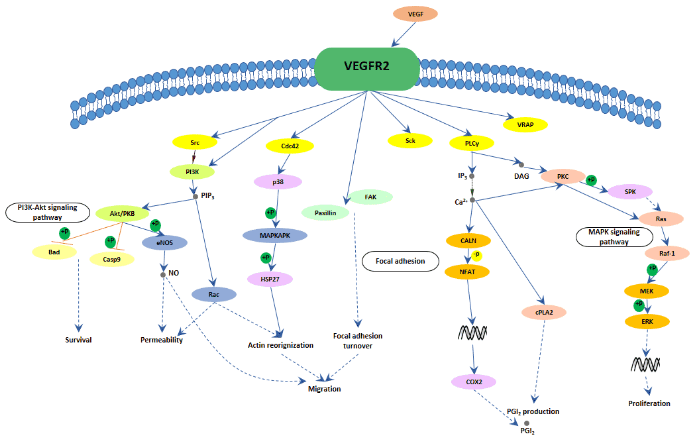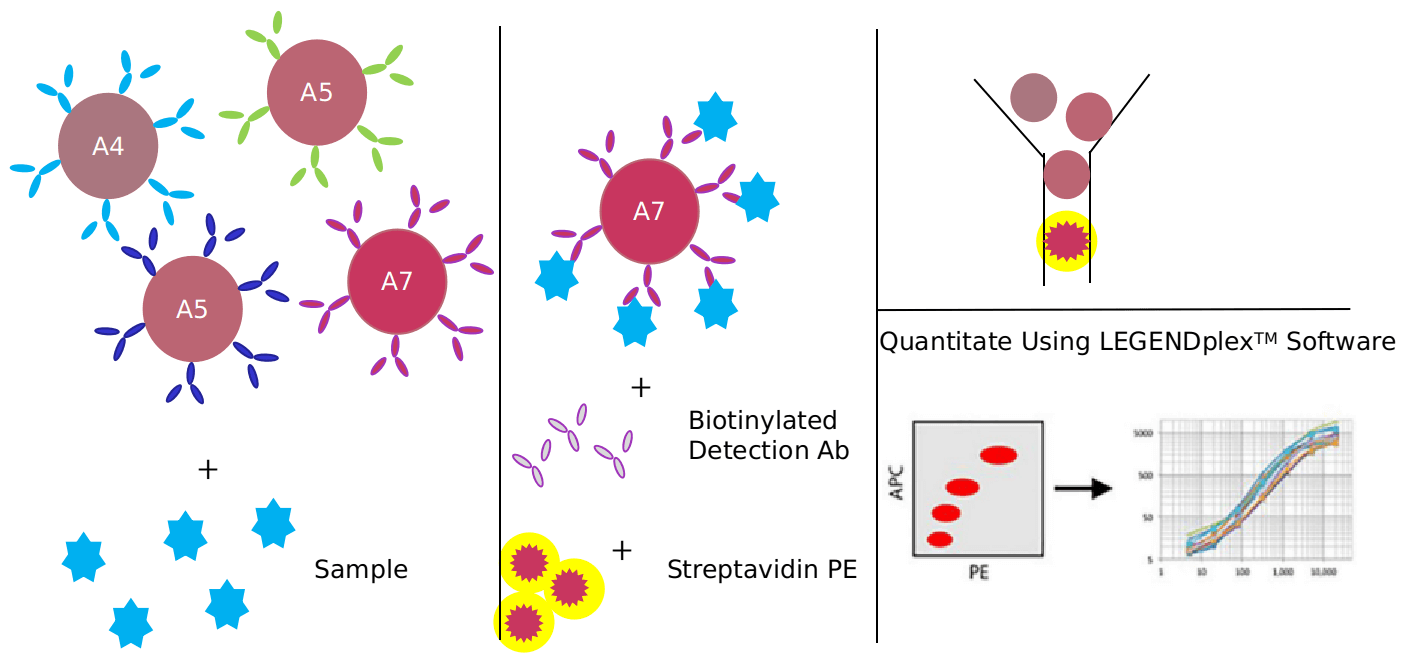Introduction to VEGF signaling pathway
Based on Luminex technology platform, Creative Proteomics provides analysis services for key targets of VEGF signaling pathway.
Vascular endothelial growth factor (VEGF) is an effective growth factor that plays multiple roles in angiogenesis and angiogenesis. In the brain, VEGF mediates angiogenesis, nerve migration, and neuroprotection. As an osmotic factor, excessive VEGF can destroy the intracellular barrier, increase the leakage of choroid plexus endothelial cells, cause edema, and activate inflammatory pathways. Recently, we have discovered that heparin binds to epidermal growth factors such as growth factor (HB-EGF) and EGF receptor (EGFR) family ligands to promote the development of hydrocephalus with subarachnoid hemorrhage by activating VEGF signaling.
VEGF is the most clearly studied of all angiogenic factors. VEGF signaling pathway plays an irreplaceable role in the whole process of angiogenesis. A large number of studies have found that VEGF promotes the proliferation, migration and chemotaxis of vascular endothelial cells in bone, lung, kidney, brain, tumor and other tissues and organs. In addition, inflammation and tumor growth stimulation are the main factors for the release of VEGF under pathological conditions.

VEGF is the main driver of angiogenesis in embryonic and adult physiological and pathological processes. It is often found that VEGF and its receptors VEGFR1 and VEGFR2 are overexpressed in tumors. Therefore, several different strategies have been designed to target VEGF signal transduction. In the past few decades, a variety of inhibitors have been therapeutically validated in preclinical models and multiple clinical trials. Neutralizing monoclonal antibodies against VEGF and small molecule tyrosine kinase inhibitors against VEGFR have been shown to block its angiogenic activity, leading to tumor vascular regression, anti-tumor effects and improved patient survival. However, in some cases, side effects and lack of efficacy challenge the potential clinical impact of these therapies.
The role of the VEGF pathway is mainly to promote the formation of new blood vessels while preserving existing blood vessels. However, when the number of endothelial cell growth factors is far greater than that of anti-vascular endothelial cell growth factors, it will cause abnormal blood vessels. In endothelial cells, there are not many studies showing that VEGFR-2 is an important regulator of VEGF-led response. However, in physiological and pathological angiogenesis, VEGFR-2 is a key signal transduction factor. The combination of VEGF and VEGFR-2 will cause different cascade signal pathways to up-regulate the expression of related genes, thereby mediating the proliferation and migration of endothelial cells and benefiting the survival of endothelial cells, as well as promoting vascular permeability.
Our detectable targets:
| JAK1 | JAK2 | TYK2 | STAT1 | STAT2 | STAT3 |
| STAT5 | IRAK4 | JNK | MYD88 | Rac1 | TLR4 |
| CREB | IRF3 | MAPK | NAP1 | Rel | TLR9 |
| FADD | IRF7 | Mda-5 | NFκB | RIG-1 | TRAF3 |
| GAS | IRF9 | MEKK1 | p38 | RIP1 | TRAF5 |
| Histone-H3 | IRF5 | MEK3 | p38MAPK | SH2 | TRAF6 |
| IKK-α | IRS1 | MEK6 | p50 | SLP76 | TRAM |
| IKK-β | IRS2 | MSK1 | p65 | Tak1 | TRIF |
| IPS-1 | ISGF3 | MSK2 | PI3K | TBK1 | Vav |
| IRAK1 | ISRE | mTOR | PKR | TLR3 |
Technology platform
We provide Luminex technology for VEGF signaling pathway analysis.
Luminex technology is a multifunctional liquid phase analysis platform developed on the basis of colored microspheres, laser technology, applied fluidics and high-speed digital signal processing technology. The core is to encode polypropylene microspheres or magnetic microspheres with fluorescent dyes. By adjusting the different ratios of the two fluorescent dyes, up to 100 microspheres with different fluorescence spectra can be obtained. Each kind of microspheres is covalently cross-linked. Capture antibodies against specific antigens.
VEGF can be applied to a variety of biological tests, including immune analysis, genotyping, gene expression, enzyme analysis, etc. It can detect both protein and nucleic acid. In addition to clinical use, it can also be used in scientific research, CDC, blood stations, agricultural, biological and pharmaceutical professional laboratories, etc.
In addition to Luminex Multiplex Assay, Enzyme-linked immunosorbent assay (ELISA), Flow cytometry (FACS analysis) technology can also be provided to meet other customer needs.
Advantages of VEGF signaling pathway detection:
- Versatility: VEGF signaling pathway technology can be applied to a variety of biological tests, including immune analysis, genotyping, gene expression, enzyme analysis, etc. It can detect both protein and nucleic acid. In addition to clinical use, it can also be used in scientific research, CDC, blood stations, agricultural, biological and pharmaceutical professional laboratories, etc.
- High-throughput and high-speed: Each microsphere is used as a separate test body, which can perform a large number of biological tests at the same time. It only needs 10~201 samples to test up to 100 indicators at a time, and the fastest can reach 10,000 tests /hour.

Application of our service:
- To study the regulation mechanism of VEGF signal pathway in disease
- To study the effect of each virus on VEGF signaling pathway
- To study the effects of drugs or therapies on VEGF signaling pathways
Creative Proteomics has developed a signal pathway target detection platform. We are not limited to providing VEGF signal path detection services, but can also provide other signal path detection services. If you want to detect other targets, please contact us and we will customize the service for you. Look forward to working with you.
References:
- Daniela Sia, Clara Alsinet. VEGF Signaling in Cancer Treatment. Current Pharmaceutical Design, 2018, 20(17).
- Shim, JW, Madsen, JR. VEGF Signaling in Neurological Disorders. 2018, 19(1).



